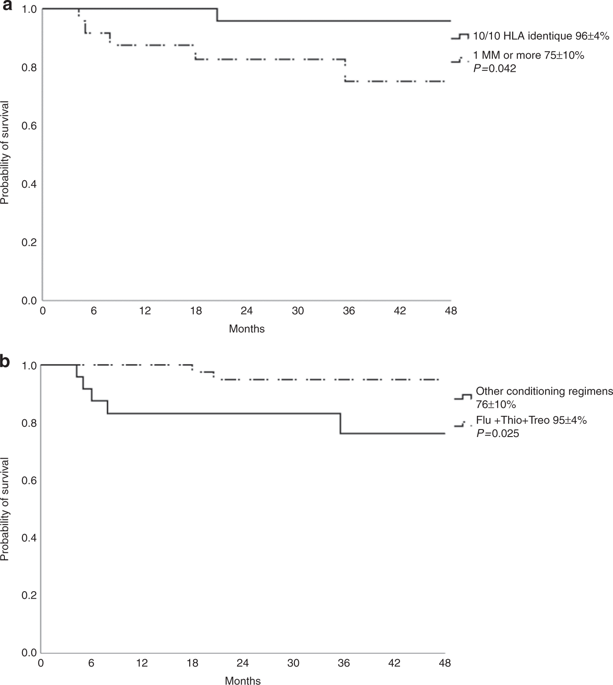Bone Marrow Transplantation ( IF 4.8 ) Pub Date : 2020-03-10 , DOI: 10.1038/s41409-020-0847-z Eliane Gluckman 1, 2 , Josu de la Fuente 3 , Barbara Cappelli 1, 2 , Graziana M Scigliuolo 1, 2 , Fernanda Volt 1, 2 , Karina Tozatto-Maio 1, 2, 4 , Vanderson Rocha 1, 2, 5 , Mina Tommaso 6 , Farah O'Boyle 3 , Frans Smiers 7 , Claudia Bettoni Da Cunha-Riehm 8 , Elisabetta Calore 9 , Sonia Bonanomi 10 , Stelios Graphakos 11 , Anna Paisiou 11 , Michael H Albert 12 , Annalisa Ruggeri 1, 2, 13, 14 , Marco Zecca 6 , Arjan C Lankester 7 , Selim Corbacioglu 15 ,

|
We report the results of an analysis of unrelated allogeneic hematopoietic stem cell transplantations (HSCT) in 71 patients with sickle cell disease (SCD) transplanted in EBMT centers between 2005 and 2017. Median age was 9.3 years; graft type was bone marrow in 79% and peripheral blood in 21%. Recipient–donor HLA match at high resolution typing was 10/10 in 31, 9/10 in 20, and 8/10 in 4 patients; the other patients had intermediate resolution typing. The most frequent conditioning regimens were fludarabine–thiotepa–treosulfan (64%) or busulfan–cyclophosphamide (12%). Cumulative incidence of neutrophil engraftment was 92%; platelet engraftment was 90%. Eleven patients (15%) experienced graft failure. Grade II–IV acute graft-vs.-host disease (GvHD) was 23%; 3-year chronic GvHD was 23%. Three-year overall survival (OS) was 88 ± 4%. GRFS was 62 ± 6%. HLA matching was the most significant risk factor for OS: 3-year OS was 96 ± 4% in 10/10 group vs. 75 ± 10% in 9–8/10 (p = 0.042); GRFS was 69 ± 9% vs. 50 ± 12% (p = 0.114), respectively. In conclusion, unrelated donor HSCT is a valid option for SCD patients who lack an HLA-identical sibling donor, preferably in the context of clinical trials. Using a 10/10 HLA-matched unrelated donor yields better survival indicating that HLA matching is an important donor selection factor in this nonmalignant disease.
中文翻译:

HLA匹配在欧洲无关的镰状细胞疾病供体造血干细胞移植中的作用。
我们报告了2005年至2017年间在EBMT中心移植的71例镰状细胞病(SCD)患者的无关异体造血干细胞移植(HSCT)的分析结果。中位年龄为9.3岁;平均年龄为9.3岁。移植类型为骨髓占79%,外周血占21%。高分辨率分型的受体-供体HLA匹配在31位患者中为10/10,在20位患者中为9/10,在4位患者中为8/10。其他患者进行中等分辨力分型。最常用的调理方案为氟达拉滨-硫替普-硫丹(64%)或白消安-环磷酰胺(12%)。中性粒细胞植入的累积发生率为92%;血小板植入率为90%。十一名患者(15%)经历了移植失败。II–IV级急性移植物抗宿主病(GvHD)为23%;3年慢性GvHD为23%。三年总生存(OS)为88±4%。GRFS为62±6%。p = 0.042);GRFS分别为69±9%和50±12%(p = 0.114)。总之,对于缺少HLA相同同胞供体的SCD患者,不相关的供体HSCT是有效的选择,最好是在临床试验中。使用10/10 HLA匹配的无关供体可获得更好的存活率,这表明HLA匹配是这种非恶性疾病的重要供体选择因素。


























 京公网安备 11010802027423号
京公网安备 11010802027423号